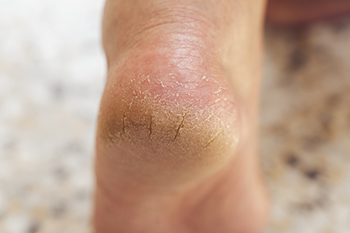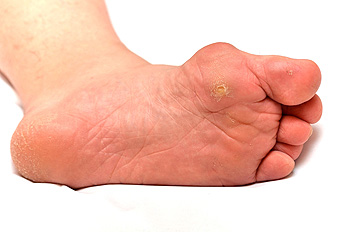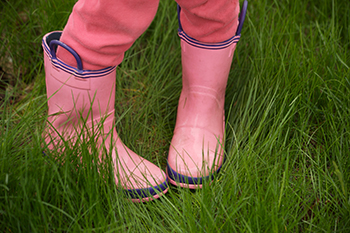
Dry cracked heels often result from a buildup of hard, dry skin that becomes less flexible and eventually splits under pressure. This condition, also known as heel fissures, can be caused by a range of factors including prolonged standing, obesity, aging, wearing open-heeled footwear, or exposure to cold weather. Certain health conditions such as diabetes, eczema, and thyroid issues can also contribute to dryness and skin thickening. Mild cases may be managed at home with regular exfoliation using a pumice stone and the use of thick moisturizers. Keeping feet moisturized and protected with well-fitting, closed-back shoes and soft socks can help retain hydration. Severe or painful cases may require treatment by a chiropodist to safely remove hardened skin and prescribe more effective topical treatments. If heel cracks persist or worsen, it is suggested that you see a chiropodist for diagnosis and appropriate treatment.
Cracked heels, also known as heel fissures, can cause pain and discomfort. If your cracked heels are bothering you, please consult with one of the chiropodists from Complete Family Footcare & Therapy. Our clinicians will assess your condition and provide you with quality foot and ankle treatment.
Dry, thickened skin around the rim of the heel is typically the first sign of cracked heels. While this condition is common and usually just a nuisance, some cases can be more severe. If left untreated and as more pressure is placed on the heel, the cracks become deeper and eventually walking and standing can be painful. These deep cracks or fissures can bleed and also become infected. Those with diabetes need to be especially careful as fissures could lead to diabetic foot ulcers.
Causes
Cracked heels can be the result of several different factors, including:
Dry skin
Taking long, hot showers or using harsh soaps
Standing for long periods of time
Walking barefoot
Walking in shoes with an open back, such as sandals or flip flops
Wearing shoes that do not fit properly
Living in a cold or dry climate
Certain skin conditions, such as eczema or psoriasis
Treatment
There are many at-home treatment remedies for cracked heels. Applying moisturizers to the heel can help hydrate the skin. Soaking your feet in warm water and exfoliating them with a loofah or pumice stone can help to buff away dead skin cells. If you are afflicted with cracked heels, it is recommended that you see a chiropodist for treatment.
Prevention
You can prevent cracked heels by:
Avoiding standing in one position for prolonged periods of time
Wearing well-fitted shoes with a closed back
Washing your feet with gentle soaps and lukewarm water
Moisturizing the feet daily
If you have any questions, please feel free to contact our offices located in . We offer the newest diagnostic and treatment technologies for all your foot care needs.

Corns and calluses are thick, hard patches of skin that form to protect the feet from pressure or rubbing. Calluses usually appear on the bottoms of the feet, especially the heels and balls of the feet, and tend to be larger and more spread out. Corns are smaller, often found on or between the toes, and may feel sore because they can press into the deeper layers of the skin. Wearing tight or poorly fitting shoes is a common cause. Walking barefoot often or standing for long hours can also lead to these rough spots. To help manage them, choose shoes that fit well and cushion your feet. If corns or calluses become painful or keep coming back, it is suggested that you see a chiropodist for advanced treatment.
Corns are small bumps or dry, hardened skin that can arise on the feet, usually in response to friction. Corns can be asymptomatic, or they can be uncomfortable or painful. If you have corns that are bothering you, please consult with one of the chiropodists from Complete Family Footcare & Therapy. Our clinicians can help you maintain the health of your lower limbs and your mobility.
There are three types of corns:
Hard corns
Often occur on the tops of toes
Feature a hard core surrounded by dry, irritated skin
Can be painful
Soft corns
Often occur in between the toes
Soft due to constant exposure to sweat
Can be painful
Seed corns
Tiny
Often occur on the soles of the feet
Usually asymptomatic
Corns can be prevented by wearing shoes that fit properly. They are typically benign and don’t require medical treatment. However, if your corns are causing you pain or discomfort, don’t hesitate to reach out to a chiropodist near you for treatment options. If you have any questions, please feel free to contact our offices located in . We offer the newest diagnostic and treatment technologies for all your foot care needs.

Pigeon toes, also known as in-toeing, refer to a condition where the feet point inward instead of straight ahead while walking or standing. In-toeing is common in children and can result from structural variations in the hips, legs, or feet. In many cases, pigeon toes improve naturally with growth, but targeted exercises can help encourage proper alignment and muscle development. Activities that focus on strengthening the hip muscles and improving flexibility can be particularly beneficial. Simple stretching routines, balance exercises, and walking drills that emphasize proper foot positioning may promote better gait mechanics. Consistency with these exercises can help retrain muscle memory and support natural correction over time. Encouraging active play and barefoot movement in safe environments can also aid in improving foot posture and overall lower body coordination. If your child has this condition, it is suggested that you consult a chiropodist who can provide additional guidance about in-toeing.
If your child is experiencing foot or ankle pain, please consult with one of the chiropodists from Complete Family Footcare & Therapy. Our clinicians will assess your condition and provide you with quality foot and ankle treatment.
Common Causes of Foot Pain in Children
While children can experience many of the same foot problems as adults do, some foot problems may be more common during childhood.
Causes of foot pain in children can include:
Deformities that are present from birth, such as flat feet or clubfoot
Sever’s disease, which is an inflammation of the growth plate in the heel bone
Various sports injuries, such as sprains and fractures
Ingrown toenails
Athlete’s foot
Plantar warts
Prevention
It is important to look after the health of children’s feet in order to prevent future problems from arising. Keep your child’s feet clean and dry, trim their toenails regularly, ensure their shoes fit properly, and keep a watchful eye on any symptoms of foot pain, such as limping. If you notice any symptoms or if your child complains of foot pain, a chiropodist can help.
If you have any questions, please feel free to contact our offices located in . We offer the newest diagnostic and treatment technologies for all your foot care needs.

